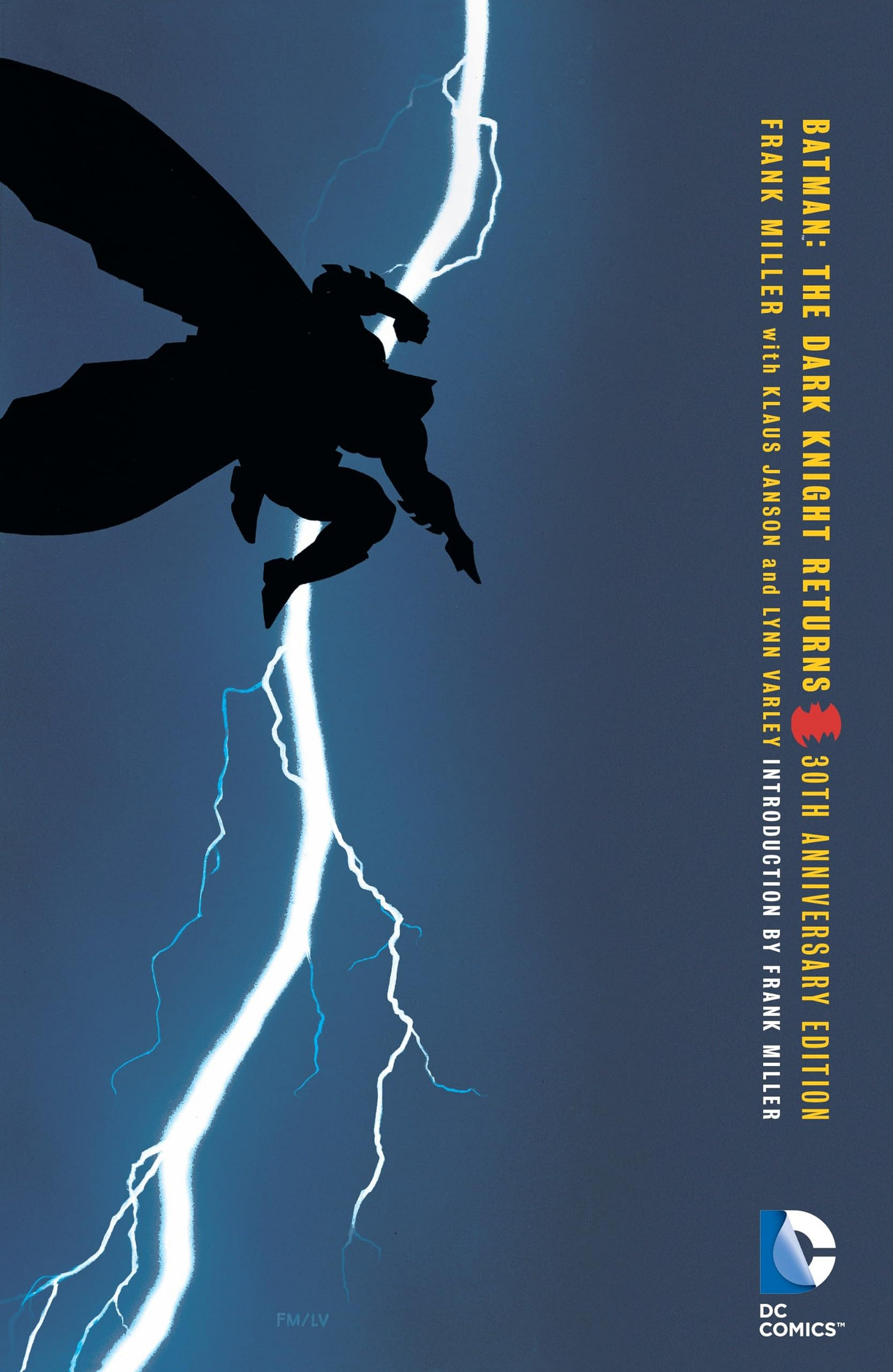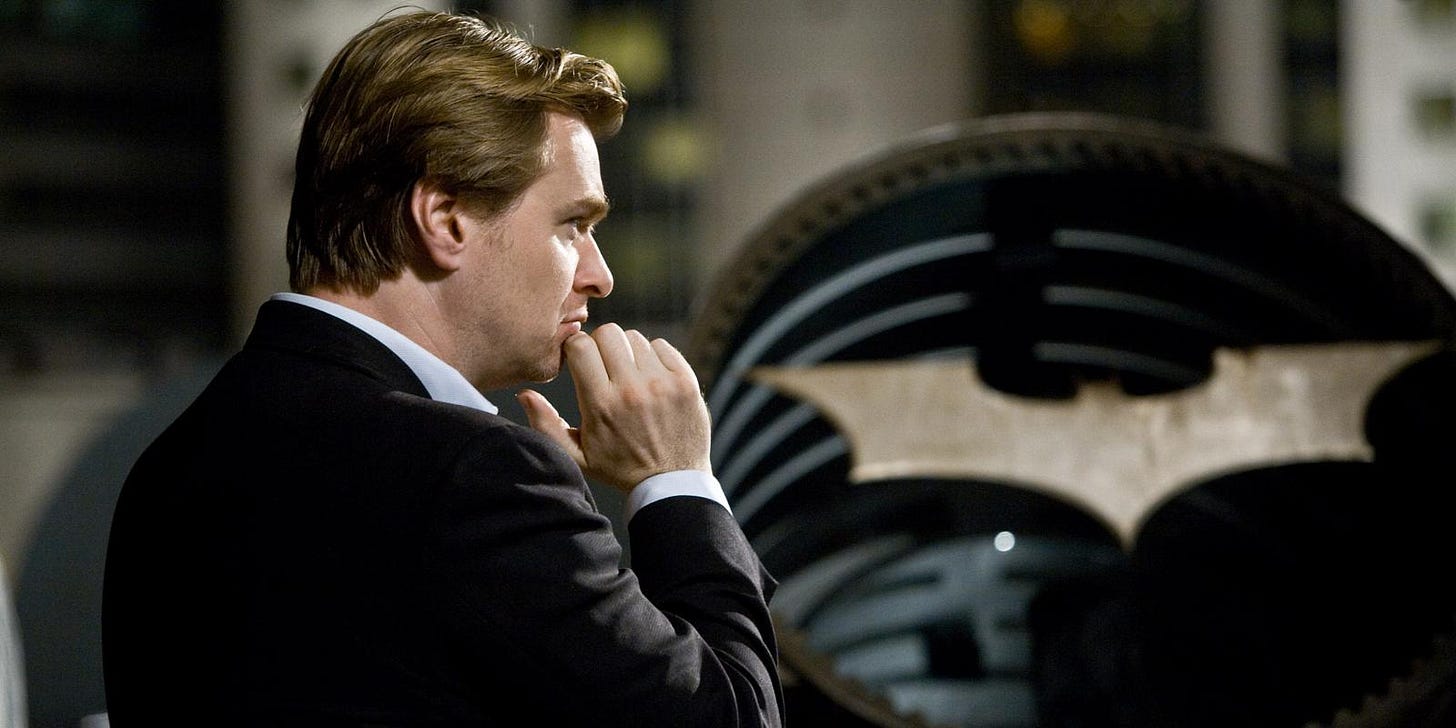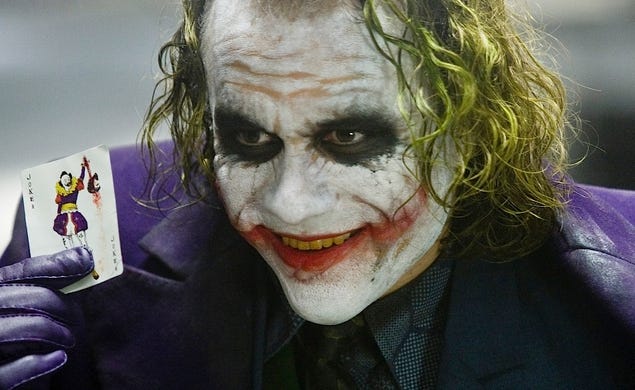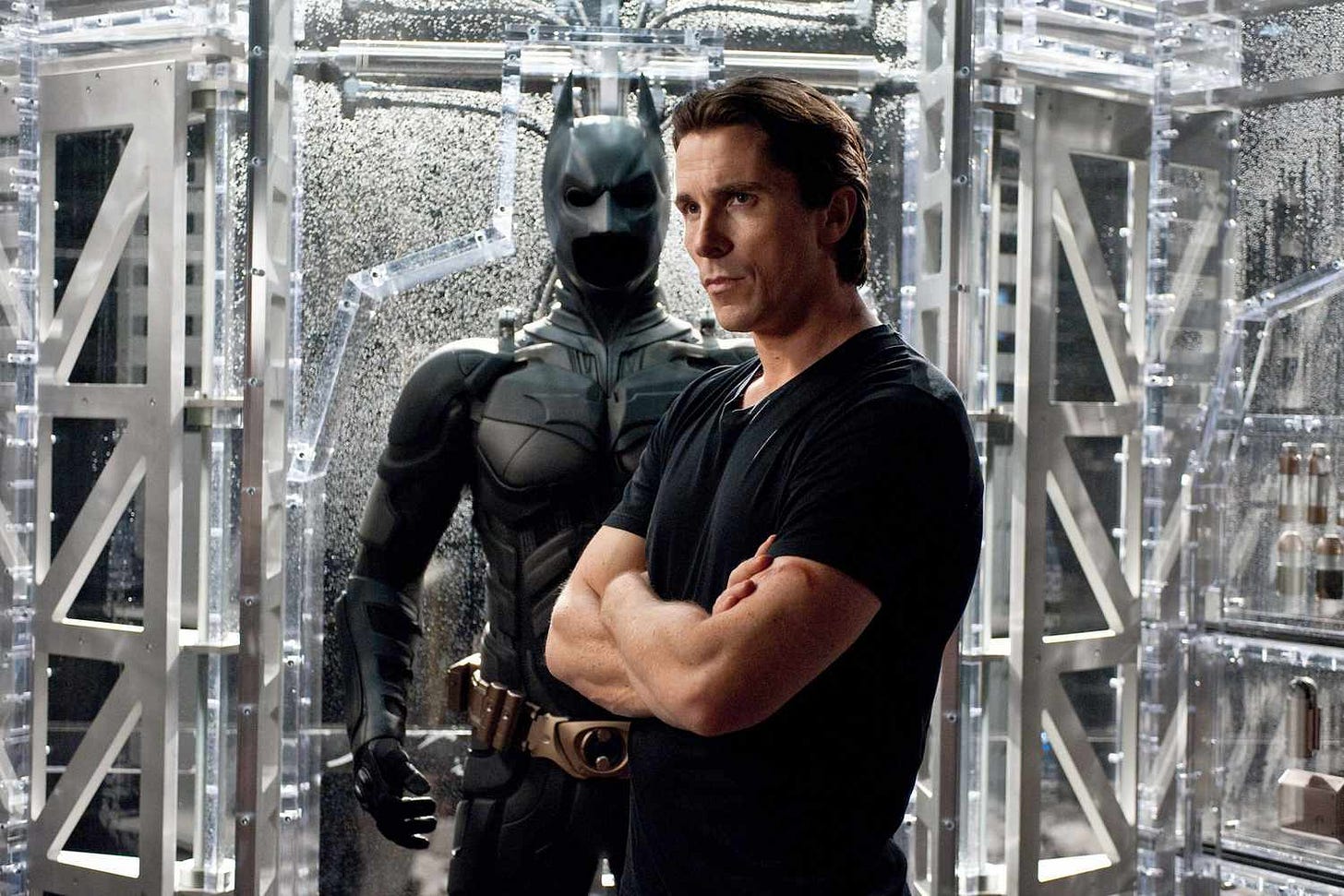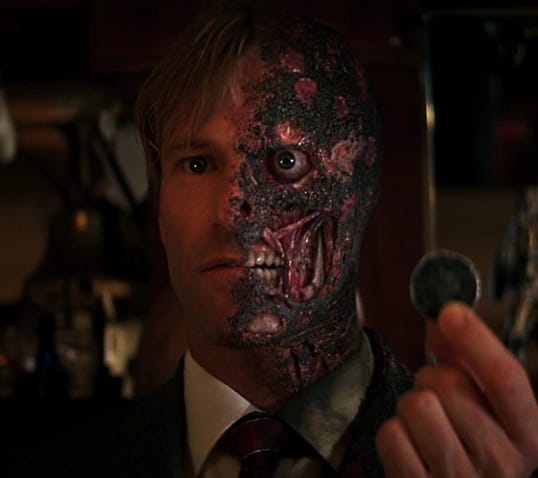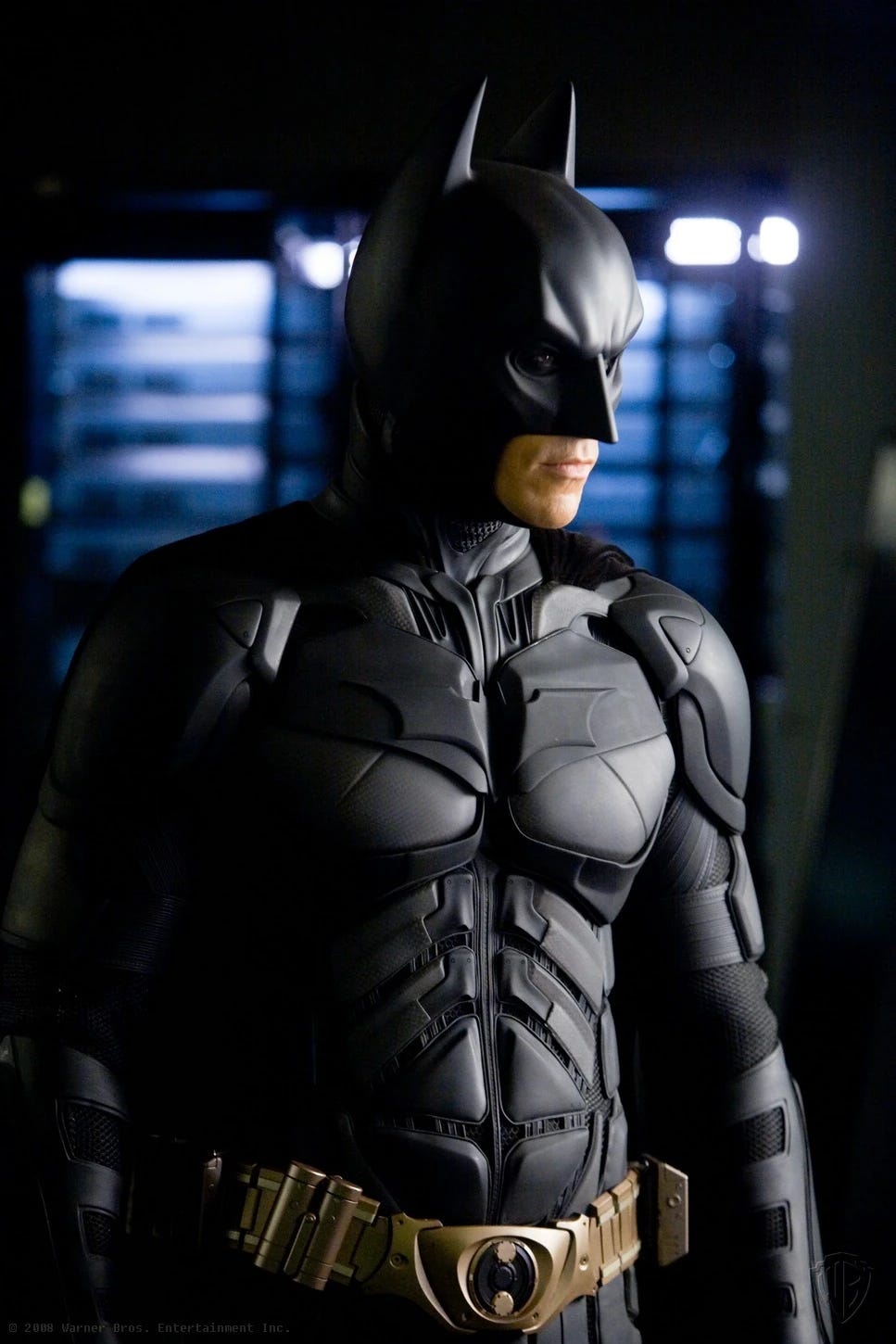Christopher Nolan's The Dark Knight, released in 2008, transcended the boundaries of the superhero genre as an action-packed thriller and a profound meditation on the darkness within society and human nature. It presented Batman, Gotham's brooding protector, as a complex figure grappling with the ethical and philosophical implications of justice, autonomy, and vengeance in a world of corruption and chaos.
Created by Bob Kane and Bill Finger in Detective Comics #27 released in 1939, Batman is the alter ego of Bruce Wayne, a billionaire playboy orphaned at a young age when his parents were murdered in front of him. This tragic event molded young Bruce, instilling within him an unrelenting desire to eradicate crime from Gotham City, a metropolis rotting from corruption and moral decay. With no superhuman abilities, Batman relies on his intellect, martial arts training, and an arsenal of high-tech gadgets and vehicles to pursue justice, all while operating in the shadows of Gotham as a symbol of fear to his enemies.
Batman: The Definitive History of the Dark Knight in Comics, Film, and Beyond by Andrew Farago and Gina McIntyre details the evolution of this character from his early inception as a noir detective to the darker, psychologically complex figure readers recognize today. Bruce Wayne's choice to don the mantle of the bat is grounded in both symbolism and psychology; he becomes what he fears most to strike terror into the hearts of criminals. Gotham’s underworld fears the myth more than the man, and Batman, aided by gadgets like the Batmobile, Batarangs, and his iconic grappling hook, becomes a nearly mythic force of nature.
Batman’s adversaries are as crucial to his story as the man behind the mask. Iconic villains like The Joker, Two-Face, and The Riddler reflect twisted mirrors of Batman’s psyche. Key storylines, such as Batman: Year One, The Long Halloween, The Killing Joke, and The Dark Knight Returns, delve deep into these confrontations, portraying Batman not just as a crime fighter but as a man grappling with the ethical complexities of his vigilante justice. In The Long Halloween by Jeph Loeb and Tim Sale, Batman navigates a yearlong mystery that forces him to confront Gotham’s worst criminals while questioning the morality of his methods. Similarly, The Killing Joke by Alan Moore examines the fine line between sanity and madness, with the Joker positing that anyone can descend into chaos with just “one bad day.” These stories establish Batman not as an infallible hero but as a man wrestling with the darker aspects of his mission.
Batman’s journey to the screen began in 1966 with the campy yet beloved Adam West-led Batman TV series. The bright, colorful tone of this series contrasted starkly with the grim noir of Batman’s comic roots, but it cemented the Caped Crusader in popular culture. Batman: Facts and Stats from the Classic TV Show by Y.Y. Flurch explores how the TV show became a cultural phenomenon, though it lacked the gravitas of later Batman adaptations. In 1989, Tim Burton’s Batman offered a darker interpretation of the character, influenced by Frank Miller's gritty depictions in The Dark Knight Returns. Burton’s gothic visual style, combined with Michael Keaton’s brooding portrayal, rejuvenated Batman’s cinematic presence. However, the franchise stumbled in the late 1990s with Joel Schumacher’s Batman Forever and Batman & Robin, which were critically panned for their campy tone and overt commercialism. These films lacked the serious, brooding essence that Batman’s mythos required, leading to a sharp decline in the character’s cinematic reputation.
The Essential Batman Encyclopedia by Robert Greenberger offers detailed accounts of this evolution, highlighting how the failures of the Schumacher films created an opportunity for a revival—a darker, more psychologically complex take on the Dark Knight.
In 2005, Christopher Nolan resurrected Batman with Batman Begins, a film that grounded the character in realism and explored the psychological roots of Bruce Wayne’s transformation into Gotham’s vigilante protector. According to The Dark Knight Trilogy by Christopher Nolan, his vision was to strip Batman of the fantastical elements that had defined previous incarnations and focus on his humanity, his trauma, and his moral struggles.
With the success of Batman Begins, anticipation was high for a sequel. The Dark Knight was developed as a continuation of the themes Nolan established in his first film while introducing the Joker, a chaotic force of nature whose philosophical beliefs about society challenged Batman’s ethical ideals. Nolan's approach, grounded in gritty realism and intense psychological drama, was heavily influenced by crime films like Heat and embraced a complex narrative structure that blurred the lines between good and evil.
The Dark Knight opens with Gotham City on the verge of renewal, as crime lords are on the run, and Bruce Wayne contemplates hanging up his cape for good. Enter the Joker, a figure of chaos who seeks to dismantle Gotham’s social order and expose its inherent fragility. The film’s sociopolitical themes are deeply embedded in the battle between these two forces—order and chaos.
Gotham’s rampant corruption is central to the narrative in The Dark Knight. Police officers and politicians are compromised, providing fertile ground for criminal enterprises to flourish. The character of Harvey Dent, Gotham’s District Attorney and self-proclaimed "White Knight," attempts to dismantle this corruption by enforcing justice through legal means. His transformation into Two-Face later in the film symbolizes the fragility of even the most idealistic figures when faced with overwhelming systemic corruption.
In his book Batman and Ethics, Mark D. White emphasizes how Gotham’s corrupt environment challenges Batman's quest for justice. The entire system is rigged against the law-abiding, and this forces Batman to operate outside of conventional justice. Key scenes illustrate this tension, such as when Bruce Wayne throws a lavish fundraiser to support Dent, aligning himself with Gotham’s last hope for legal reform. However, the scene is interrupted by the Joker, who embodies chaos and offers an alternative to Gotham’s morally bankrupt institutions. Here, Nolan juxtaposes corruption with autonomy, showing how societal collapse pushes individuals like Batman and Dent to act in ethically ambiguous ways.
Autonomy, or the freedom to make one’s own decisions, is challenged throughout the film, especially by the Joker. In Batman and Philosophy: The Dark Knight of the Soul, White, and Arp explore how the Joker undermines individual autonomy by creating scenarios where people are forced to make impossible choices. The most iconic example is the ferry scene, where two boats—one filled with civilians, the other with prisoners—are given the option to blow up the other to save themselves. The scene presents a clear utilitarian dilemma, where one group must decide whether to sacrifice the other for their survival. By placing the fate of the other in their hands, the Joker strips them of their moral autonomy and attempts to prove that when pushed to the brink, humans will abandon ethical principles in favor of self-preservation.
This scene reflects the film's broader meditation on utilitarianism. Mark D. White, in Batman and Ethics, uses this example to highlight how Batman resists the utilitarian urge to sacrifice the few for the many, embodying a Kantian commitment to treating everyone as an end in themselves. Batman’s refusal to kill, even the Joker, underscores his belief in moral duty over consequentialist logic, despite the potential cost to Gotham’s safety.
Mental health, particularly the Joker’s psychopathy and Batman’s struggles with trauma, lies at the heart of The Dark Knight’s exploration of individual and societal well-being. Travis Langley, in Batman and Psychology: A Dark and Stormy Knight, analyzes how both Batman and the Joker represent two sides of mental illness. Batman channels his trauma into a strict moral code, whereas the Joker embraces chaos, dismissing societal norms entirely. The Joker’s assertion that everyone is “one bad day” away from madness reflects a deep existentialist viewpoint: life is absurd, and one’s moral compass can be shattered in an instant, as illustrated in Harvey Dent’s transformation into Two-Face.
The film’s exploration of mental health extends beyond individual struggles to critique societal failure in addressing these issues. Gotham’s institutions, particularly Arkham Asylum, fail to rehabilitate or contain individuals like the Joker, highlighting the limitations of a system designed to punish rather than heal. The scene in which the Joker manipulates the hospital’s mentally ill patients to cause havoc is emblematic of how vulnerable individuals can be used as pawns in larger schemes of destruction. This reflects care ethics, a framework that stresses the importance of caring for individuals, especially those marginalized by society. As the film shows, neglecting care leads to further societal breakdown.
Crime and revenge are pervasive in The Dark Knight, with the Joker orchestrating mayhem to demonstrate the futility of Gotham’s moral structures. As Kevin K. Durand and Mary K. Leigh discuss in Riddle Me This, Batman!, the Joker’s philosophy is rooted in egoism and hedonism, seeking only to serve his pleasure and rejecting societal norms altogether. His goal is to prove that Gotham’s citizens, including its hero, Batman, are no different from him when stripped of their moral pretensions.
This is most evident in Harvey Dent’s transformation into Two-Face, which is driven by revenge. After losing Rachel Dawes and suffering physical disfigurement, Dent’s quest for justice turns into a personal vendetta. In his final confrontation with Batman, Dent abandons any pretense of serving the greater good, resorting to flipping a coin to decide the fates of others. This reflects a descent into egoism, where personal pain and anger eclipse moral considerations. The Dark Knight critiques this cycle of violence, illustrating how revenge corrodes individuals and societies alike. Mark White discusses in Batman and Ethics that Batman himself struggles with revenge, particularly in his refusal to kill the Joker, knowing it would only perpetuate the cycle of violence.
At the center of The Dark Knight lies the concept of justice. Batman’s vigilantism exists in tension with Gotham’s legal system, which is corrupt and ineffective. Throughout the film, Batman grapples with the limits of justice—how far he is willing to go to achieve it without compromising his ethical code. This struggle is best encapsulated in the scene where Batman tortures the Joker to extract information about Rachel and Dent’s whereabouts. Although Batman is desperate, he ultimately fails, as the Joker has already planned for this and uses it to demonstrate that even Batman, under enough pressure, will resort to brutality.
Here, the film engages with virtue theory, as Batman must constantly assess whether his actions align with his ideal of a virtuous hero. Virtue ethics, which emphasizes character and the cultivation of moral virtues like courage and temperance, plays out through Batman’s internal conflict. Batman and Philosophy: The Dark Knight of the Soul discusses how Batman strives to live by the virtues of justice and restraint, even as the Joker tests his limits.
The final act, where Batman takes the blame for Dent’s crimes to preserve Gotham’s hope, encapsulates Kantian ethics. Batman makes this decision based on duty rather than outcome, upholding a moral ideal even when it leads to personal sacrifice. As Langley writes in Batman and Psychology: A Dark and Stormy Knight, this choice demonstrates Batman’s commitment to a higher ethical standard, one that prioritizes the greater good over his reputation.
The Dark Knight is also a film about existentialism. Both Batman and the Joker operate from existentialist frameworks: Batman creates his meaning by choosing to fight for justice, while the Joker, as a nihilist, rejects the very idea of meaning, opting instead to reveal the absurdity of life. The Joker’s chaotic actions are an attempt to force others to confront this absurdity, as seen in his manipulation of Harvey Dent. By showing Dent that life is governed by chance, not justice, the Joker tries to dismantle Gotham’s moral structures entirely.
Batman and Philosophy: The Dark Knight of the Soul by White and Arp discusses how Batman’s commitment to justice, despite the overwhelming forces of chaos around him, mirrors existentialist themes of choosing one's values in an indifferent universe. This is Batman’s ultimate triumph over the Joker—despite the chaos, he maintains his moral code, showing that meaning can be created even in the face of absurdity.
The performances in The Dark Knight elevated the film beyond the superhero genre. Christian Bale, reprising his role as Bruce Wayne/Batman, brought depth to the character’s internal conflicts, while Michael Caine’s portrayal of Alfred provided a moral compass in Bruce’s darkest moments. Heath Ledger’s Joker, a performance that earned him a posthumous Academy Award, redefined the villain archetype. Ledger imbued the Joker with unpredictability and an unsettling philosophical complexity that transcended mere villainy, making him a symbol of chaos and nihilism. Gary Oldman’s Commissioner Gordon portrayed the everyday heroism of those working within a broken system, while Aaron Eckhart’s transformation from Harvey Dent to Two-Face illustrated the dangers of losing oneself to revenge. Maggie Gyllenhaal’s Rachel Dawes served as a moral anchor, highlighting the personal costs of Bruce Wayne’s crusade. Finally, Morgan Freeman’s Lucius Fox illustrated the ethical dilemmas of surveillance and security in an age of increasing technological dominance, foreshadowing real-world debates about privacy versus safety.
Nolan, alongside his brother Jonathan, producer Emma Thomas, and producer Charles Roven, crafted a film that balanced intense action sequences with profound ethical questions. The brothers’ script is structured to interrogate the nature of justice, autonomy, and the limits of morality. The contributions of Hans Zimmer’s iconic score and Wally Pfister’s cinematography added emotional gravitas to the film’s philosophical undertones.
Upon release, The Dark Knight became an instant commercial success, grossing over $1 billion worldwide and setting new records for superhero films. It was praised for its mature, complex storytelling and hailed as one of the greatest films of the 21st century. The Dark Knight racked up eight Oscar nominations, with Heath Ledger winning Best Supporting Actor for his unforgettable role as the Joker, and the film also taking home the award for Best Sound Editing. It transformed both Nolan’s career and the superhero genre, proving that comic book films could deliver sophisticated storytelling and profound themes while earning critical acclaim.
Over sixteen years after its release, The Dark Knight remains influential in both the superhero genre and cinematic storytelling. Its success paved the way for darker, more mature superhero films, and its ethical explorations continue to resonate with audiences in an increasingly polarized world. Films like Logan and Joker drew significant inspiration from The Dark Knight, particularly in their deep exploration of their protagonists' psychological struggles and moral dilemmas. As part of the larger Dark Knight Trilogy, the film's impact extended beyond its initial release, inspiring discussions on the nature of heroism, the complexities of justice, and the ethical dilemmas that arise when individuals take the law into their own hands.
The Dark Knight is a profound exploration of sociopolitical dynamics and ethical principles. Through its complex characters, gripping narrative, and deep philosophical undertones, the film challenges viewers to question the nature of justice, the role of autonomy, and the moral boundaries of vengeance. As Christopher Nolan’s masterpiece, it will continue to be studied and revered for its ability to transcend genre and offer timeless insights into the human condition.





